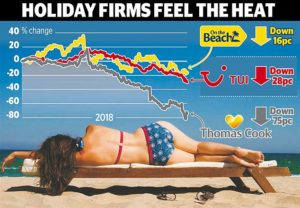Pick the best (and cheapest) investment Isa platform
6 min read
The rise of DIY investing has delivered a revolution in the way investors buy shares, investment trusts and funds – offering them huge savings and a big boost to their returns through online brokers.
Not so long ago, investing typically required a stockbroker or financial adviser and the willingness to hand over a big chunk of commission.
Now armed with a computer – or in some cases even just a smartphone – investors can use a DIY investing platform or online broker and the wealth of research at their fingertips to hopefully build their fortune.
But picking the right DIY platform is crucial and the array of different options has left many investors scratching their heads.
We explain how to decide on a DIY investment platform to invest in the full range of options: from shares, funds and investment trusts, to ETFs and direct retail corporate bonds.
Check the table for the brief details and read our full round-up of each platform’s features and who they could be good for below. Also read Simon Lambert’s column on exit fees and how he got a £750 bill.
| Admin charge | Charges notes | Fund dealing | Standard share, trust, ETF dealing | Regular investing | Dividend reinvestment | |||
|---|---|---|---|---|---|---|---|---|
| AJ Bell YouInvest | 0.25% | Max £7.50 per quarter for shares, trusts, ETFs. | £1.50 | £9.95 | £1.50 | 1% (Min £1.50, max £9.95) | More details | |
| Alliance Trust | £120 (£10 per month) | Includes four free trades a year | £9.99 | £9.99 | £1.50 | £5 | More details | |
| Barclays Direct Investing* | 0.2% on funds, 0.1% on other investments | Min monthly fee £4, max £125 | £3 | £6 | £1 | Free | More Details | |
| IG | £96 (£24 per quarter, waived if three trades in period or £15,000-plus in Smart Portfolio) | Shares, ETFs and trusts only (No funds) | n/a | £8 | n/a | n/a | More details | |
| Charles Stanley Direct** | 0.25% | Platform charge waived on shares if one trade in that month. Annual min £24 and max of £240 on shares. | Free | £11.50 | n/a | n/a | More details | |
| Fidelity | 0.35% on funds | £45 flat fee up to £7,500. Max £45 per year for trusts and ETFs (Some shares) | Free | £10 | Free funds £1.50 shares, trusts ETFs | £1.50 | More details | |
| Hargreaves Lansdown | 0.45% | Capped at £45 for shares, trusts, ETFs | Free | £11.95 | £1.50 | 1% (£1 min, £10 max) | More details | |
| Interactive Investor | £90 | Admin fee back in trading credits built up to max of £90 | £10 | £10 | £1 including funds | £1 | More details | |
| iWeb | £25 one-off | £5 | £5 | n/a | 2%, max £5 | More details | ||
| Share Centre | £57.60 | 1% £7.50 min | 1% £7.50 min |
0.5%, min £1 | 0.5%, min £1 | More details | ||
| Tilney Bestinvest | 0.40% | n/a | Free | £7.50 | n/a | n/a | More details | |
| Vanguard | 0.15% | No fee above £250k (£365 cap) Only Vanguard funds |
Free | Free only Vanguard ETFs | Free | n/a | More details | |
| Funds only | ||||||||
| Cavendish | 0.25% | Free | Funds only | Free | n/a | More details | ||
| (Source: ThisisMoney.co.uk March 2018, Admin charges quoted annually, may be collected monthly or quarterly) | ||||||||
Why does an Isa or investing platform matter?
The right Isa wrapper or investing account has the power to boost your investments, helping you to build a portfolio and limiting how your hard-won returns are eaten into by fees.
DIY investing platforms act as a place to buy, sell and hold all your investments and a tax-efficient wrapper around them if you choose to invest in an Isa.
When weighing up the right one for you, it’s important to to look at the service that it offers, along with administration charges and dealing fees, plus any other extra costs.

We highlight Isa and non-Isa charges, but don’t forget that investing in an Isa makes sense, as it should protect your hopefully growing investments from as much tax as possible.
The good news is that costs are consistently being trimmed and being made more transparent.
Something that complicates picking a platform is that DIY investors can hold a variety of assets in their Isa – not just one fund or a handful of them.
Charges vary for those Isa investors choosing to hold investment trusts, ETFs, shares and directly traded corporate bonds, alongside traditional managed funds in the form of OEICs and unit trusts.
Bearing all of this in mind we’ve busted the charges of what we consider some of the best (and cheapest) DIY investing platforms. We would advise considering the points below first.
Flat fee vs percentage charge
DIY investing platform prices can be chiefly be split into two camps. Some charge a flat administration charge, while others charge a percentage of investors’ holdings.
The former tend to always charge for buying and selling investment funds, while the latter may bundle this cost in and offer free fund dealing.
All charge for buying and selling shares, investment trusts and other products that are not funds, but the dealing fees vary from as low as £5 to about £12.
If you are a buy and hold investor putting away a large sum of money then you may benefit from a flat fee rather than percentage-based charging, which can mount up to a hefty amount.
But if you plan on buying and selling regularly watch our for dealing charges, as these can also add up substantially and easily erode the gain from a flat fee. Lower charges for regular monthly investing can substantially cut costs.
Five things to consider when picking a platform
1. Cheapest is not always best: You need to think about a combination of price and service – it is worth paying for quality but make sure you are actually getting that.
2. What will you invest in: Different dealing fees for shares, investment trusts and funds mean you need to think about how you will invest and tailor your choice accordingly.
3. Tools and information: What level of useful portfolio building tools and information does a platform offer?
4. Overall charges: Don’t just look at the admin fee or dealing charges. You need to combine both to get a true cost, along with costs such as dividend reinvestment and regular dealing charges. A low admin fee might look good but if you are an active investor who buys and sells a lot, then dealing charges will soon rack up and send costs soaring.
5. Extra fees: Check for regular monthly investing discounts, dividend reinvestment fees, transfer charges and other elements
Compare the best DIY investing platform for you
Below we publish our view on the best DIY investing platforms and explain who they are good for and why we have picked them.
We have also created a new tool to help you compare the best DIY investing platforms and online brokers with our partner BrokerCompare.
You can select how you want to invest, whether in a general account, Isa, Sipp or combination of these, and how much you will invest and how often you are likely to buy and sell funds and shares.
It will then do the calculations to show you which DIY investing platforms and online brokers look like the best deal for you. Try it now and if you have any feedback on it, please email editor@thisismoney.co.uk.
> Use our DIY investing platform comparison tool
How we choose the best DIY investing platforms
We have focused on two vital aspects, cost and quality. This is not a collection of all of the absolute cheapest platforms, these are some we think stand out and that also compete keenly on price.
All discount initial fund charges down to zero in most cases. Some funds can still carry an initial charge though – platforms should provide you with a list to check.
We have picked DIY Isa platforms to suit different investors and focus on those that offer a choice of investments – not just funds. Each one will be better for some investors than others and you should choose depending on your needs. Remember there are plenty of others available too.
This list is in no particular order.






